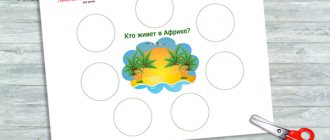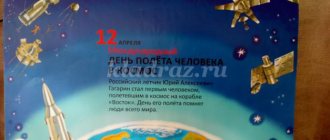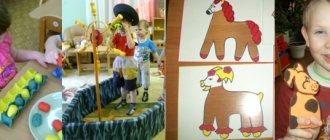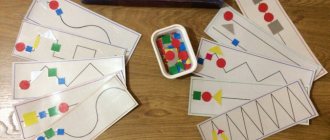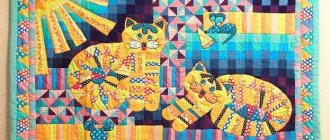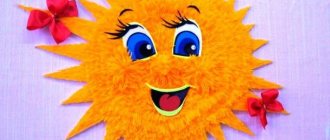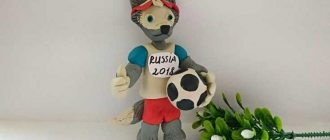A didactic game is a series of educational activities that develop certain skills in a playful way. It does not burden preschoolers like a regular lesson and contributes to the development of children’s interest in acquiring knowledge.
Concentrating the attention of young children is very difficult. The lesson helps them develop speech, thinking and learn a lot of new things in a relaxed atmosphere. With the help of didactic games, the assimilation of information is increased.
The lesson “Who Lives Where” increases the intellectual level of preschoolers. They gain a lot of new information, which contributes to their overall development.
Didactic game “who lives where”
The goal is to reinforce existing knowledge and supplement it with new information. If kids have certain basic knowledge about animals living at home and in the forest, then children in the older group should have an idea of both the forest and sea worlds. They also need to easily distinguish between them and divide them into wild and domestic ones.
This activity helps improve visual and auditory perception and also develops speech. Based on the results, children can tell what they learned from this lesson.
The material consists of cards with images of animals and their homes. You can make all this with your own hands.
You need to print out pictures of various animals and drawings of their habitats. You can draw all this yourself. Material has been developed for middle-aged children. For long-term use, drawings of the habitat can be made on hard cardboard, and the inhabitants can be mounted on old disks or on photographic paper.
The lesson can be conducted for teams of 4-6 people, or individually.
Team training proceeds as follows:
- The group is divided into teams.
- Each of them is given a picture of their habitat and a set of cards with different representatives.
- The task is announced: “It is necessary to select the inhabitants of this world.”
- The result is checked.
- The teacher and all teams pronounce mistakes and voice the correct answers.
- The one who chooses the animals as correctly as possible wins.
A lesson option with the whole group is possible. In this case, each player has his own card, and drawings of the habitat are fixed on the stand.
- Cards are distributed.
- The teacher asks the question: “Who lives where?”
- Participants take turns naming the animal from the given picture and pronouncing its habitat.
- The leader asks leading questions and helps students make the right choice. As the lesson progresses, he tells interesting facts about all the representatives.
Each age has its own goal.
- For pupils of the younger group, the goal is to master the names and appearance of animals. The lesson has a cognitive function. A simplified variation is possible. You can draw shadow silhouettes on pictures of your habitat. Little ones can display animal-shaped cards on top of the silhouettes. This promotes the development of fine motor skills and logical thinking.
- For middle school students, it is very important to instill an interest in the world around them and teach them to associate an animal with its habitat. Preschoolers should be able to determine what kind of representative it is and where it lives. Team activities are well suited for this age group.
- For students in the senior group, it is necessary to focus on speech development. The game teaches them to tell what kind of animal it is, where it lives and what its characteristics are. Variation - a short story about him. The teacher helps the child correctly formulate his thoughts using questions. If a preschooler cannot cope with a task, he helps him.
For better assimilation, the didactic material “Who lives where” can be divided into several lessons: “Who lives in the forest”, “Who swims in the sea”, “Who lives next to people” and others.
Card No. 1
Card No. 3
Card No. 2
Lesson summary (GLC) Middle group “Who lives where?”
Lesson summary (NNOD) Middle group
"Who lives where?"
Educational area:
Cognition
Chapter:
Ecology
Subject:
"Who lives where?"
Triune task:
(education, training, development).
Tasks:
Teach to compare, contrast, give an idea that animals need food, water, air, and warmth to live. Develop cognitive abilities. Cultivate a love for the animal world.
Equipment:
Letter, poster with images of wild and domestic animals, ball.
Expected Result:
Know:
About the habitat, characteristic features, methods of movement of different animals. That animals need food, water, air, warmth to live.
Have
ideas about the life of plants and animals, about the relationship between human behavior in nature and the state of the environment.
Be able to:
Compare, contrast, answer the teacher’s questions in complete sentences.
| Stages of activity | Teacher's actions | Children's actions |
| Motivational and incentive | Surprise moment. I bring the letter into the group and read it out. I invite the children to fulfill Dunno’s request and introduce them to animals and their habitat. | The children are interested and listen carefully. The children agree with the teacher. |
| Organizational search | I make riddles about wild animals. I'll tell you riddles, and you guess who it is. She is more cunning than all the animals, she has a red fur coat (Fox). Gray and toothy, prowls the field, looking for calves, lambs (Wolf). Who goes to sleep in the den - a wolf, a bear or a fox? (Bear). Questions for children about animals. I make riddles about pets. Vocabulary work. Game “Who is doing what” I throw the ball and name the animal, and you catch the ball and say what this animal does? -Cow. -Cat -Horse -Dog. — Tell me, is it possible to keep such pets at home in the city? Why not? -Tell me guys, who takes care of wild animals in the forest? Who takes care of pets? | Children try to give correct answers to riddles. Listen carefully and compare animals. They listen carefully and answer questions. |
| Reflexive-corrective | Who did we talk about in class today? -Did you guys like today’s lesson? What exactly did you like? Remember guys, we need to take care of animals and nature, because they are interconnected. Now all we have to do is write a letter to Dunno about today’s lesson so that he can learn more about animals. | Children's answers to the teacher's questions. The children agree with the teacher. |
Analysis:
The children of the entire group answered all the questions correctly, answered all the riddles, and knew which animals should be kept at home. When playing the game, they try to imitate animals.
Who lives in the forest
This lesson is dedicated to forest representatives. In this case, the pictures should depict animals living in the forest.
During the lesson, the teacher tells what animals live there, shows what they look like, and in conclusion gives a small task.
Each participant gets a drawing depicting a forest animal. We need to tell him everything he knows about him. Thus, the studied material will be well consolidated.
Card No. 4
Card No. 5
For such an activity, you can think of a soundtrack with the voices of forest animals. It is advisable to place a large poster depicting a forest on the board. Using stickers, you can attach cards with animals to it. This will develop not only auditory, but also visual memory.
The topic is “Who Lives Where?” classes in kindergarten
SAMPLE SUMMARY OF A SUB-GROUP LESSON ON FORMATION OF CONNECTED SPEECH (SCHOOL PREPARATORY GROUP)
Municipal budgetary preschool educational institution kindergarten "Solnyshko" Nikiforovsky district, Tambov region
The topic is “Who Lives Where?”
prepared by - teacher - speech therapist Seredina Nelly Aleksandrovna, r.p. Dmitrievka
Objectives of the lesson: - To consolidate knowledge about wild animals, to introduce them to their homes. — Expand and activate vocabulary on the topics “Wild Animals”, “Winter”. — To develop practical skills in the correct use of relative adjectives, to consolidate the ability to coordinate nouns with adjectives. — Clarify the lexical meaning of the words: chest, casket, donut, tower, fly. — Develop skills of connected statements, cognitive abilities, imagination, creativity. — To form an ecological culture, to cultivate a sense of beauty.
Equipment:
Tape recorder, disc with recording of music by P.I. Tchaikovsky "Seasons"; items for the “winter forest”: artificial spruce trees, stumps, branches, cotton wool, snowflakes, white paper (road with hare tracks), a basket with nuts and cones, soft toys: bear, hare, squirrel, wolf, hedgehog, fox; flannelograms (boards) (one large and two small); painting material (wild animals, their homes, two or three Christmas trees, bushes, the sun, snowdrifts, clouds, snowflakes, etc.), bunny masks.
Lexical material:
- nouns: squirrel, bear, fox, hedgehog, hare, wolf, dwelling, woodpecker, hollow, hole, den, lair, crown; - adjectives: wild, squirrel, bear, fox, hare, wolf, clubfoot; - verbs: settle, insulate, hollow out.
Organizing time
Speech therapist. Today guests came to our lesson. Guess who? Jump-hop along the trees, Yes, nuts click-click. Children. A squirrel came to us.
After each answer, the speech therapist puts a picture of an animal on the flannelgraph (board).
Speech therapist. How did you guess? Children. The squirrel eats nuts. She is fast and jumps easily. Speech therapist. In summer he walks with a clubfoot, and in winter he sucks his paw. Children. Bear. Speech therapist. How do you understand the word clubfoot?
Children offer options for the lexical meaning of a given word, which are usually inaccurate. The speech therapist explains: “To walk with a clubfoot is to step with your heels apart, awkwardly, awkwardly.”
Speech therapist. Red-haired, cunning, steals chickens. Children. Fox. Speech therapist. What does cunning mean? Children. Smart. She is deceiving everyone. The fox hides her intentions (desires). Speech therapist. The creeper crawls, carrying needles on itself. Children. Hedgehog. Speech therapist. What else can you say about the hedgehog? Children. It has prickly needles. He eats apples. In winter it sleeps for a long time. Speech therapist. Long ear, ball of fluff, jumps deftly, loves carrots. Children. Hare.
Speech therapist. What else can you say about the hare? Children. He changes his fur coat; in winter it is white. The hare is afraid of everyone. Speech therapist. Who walks around angry and hungry in the cold winter? Children. Wolf.
Speech therapist. Why do I call these animals wild? Children. They live in the forest and are afraid of humans. These are untamed animals.
Message of the topic of the lesson : Speech therapist. Now we will continue the conversation about wild animals and their homes. How do you understand the word dwelling? Children offer options for the lexical meaning of a given word, which, as a rule, are inaccurate. The speech therapist explains: “Dwelling is a place where animals live away from human habitation.” You know the names of some animal dwellings. But we’ll see what they look like in a fairytale forest.
Main part
1. Conducting a psycho-gymnastic sketch
Music is playing
Speech therapist. Close your eyes and imagine everything I am going to tell you about. Winter is on the street. Everything around is white and white. The snow sparkles in the cold and crunches underfoot. We got on our skis and went into the forest. It's quiet in the forest. The branches of the trees became heavy with snow and sank down. The trees are like something out of a fairy tale: fluffy snowflakes cling to all the branches. The crown (the so-called upper part of the tree) is all dazzling white, only the trunk darkens against the background of fluffy snow. As soon as the breeze blows, the snow begins to fall off the branches. And it's so beautiful. Now, children, let's open our eyes. I'll tell you a secret that a small corner of a fairytale forest is located next to us.
The children, together with the speech therapist, go to another room where a “winter forest” has been created.
Take a closer look and listen. What do you see? What do you hear? Children. It's quiet here. There are green Christmas trees strewn with snowflakes. There are birds in the trees. A squirrel sits in a hollow.
The music stops. Speech therapist. Where? Show it to me. What is the name of her house? Children. Her house is called a hollow. Speech therapist. A squirrel cannot hollow out a hole for itself. Where does this hollow come from? How do you think? Children. Another squirrel lived there. A squirrel found a home in an old tree. Speech therapist. Squirrels settle in the hollow left by the woodpecker. They insulate it with moss, dry leaves and grass. (He opens the basket, overturns it, nuts and small pine cones roll out in the “snow.”) Oh! What have I done. Where do you think this comes from? Children. These are squirrel reserves for the winter. She collected it herself. Speech therapist. Take a nut or cone and place it on your palm. Consider them.
2. Carrying out finger exercises and exercises to prevent visual impairment
Speech therapist. Let's play with nuts (cones). Children squeeze nuts (cones) into their fists (5-10 times), roll them between their palms (up and down, left and right), make circular movements on their palms, then extend their right arms, hold these objects with their thumb and forefinger and slowly move their arms away right, left, make circular movements with their hands and carefully follow the movement of the object with their eyes, without turning their heads.
Speech therapist. You did very well. Place the nuts and cones in a basket and leave them for the squirrel. Now look, what is this? (Puts out a picture.) Speech therapist. Guys, look, what is this? Children. This is a hole. We see the fox's tail. This is the fox's house. Speech therapist. This is a fox hole. Let's repeat the name of the fox's house. Children pronounce the sentence in chorus and individually. Speech therapist. What is the name of the bear's home? Children. Den. Speech therapist. Let's fantasize and imagine how a bear builds a den? Children. A large tree fell and the bear crawled under it. It's a big hole with branches on top. Speech therapist. I accept your answers and agree with you in many respects: the bear makes a den in a large hole, always in a dry place, along an upturned tree with roots, and falls asleep there. Where do you think the bear is located in our “forest”?
The children point to a large “snowdrift”. Speech therapist. But we won’t disturb the bear; let him sleep in his den. Who else sleeps in winter? Children. Hedgehog. Speech therapist. What kind of home does a hedgehog have? Children. He sleeps in the leaves. Speech therapist. Hedgehogs sleep for six months. They crawl under a pile of leaves, grass, branches, and sometimes under the roots of old trees. Now look, what are these traces? (Puts out a picture.) Children. These are traces of a fox and a hare. Speech therapist. Right. Now we will turn into bunnies and jump in the rabbit's tracks. I think they will lead us to the hare's house.
3. Dynamic pause Children put on hats with ears and jump in the rabbit's tracks. Speech therapist. Where do you think the hare is? Why is he not in his home? Children. The hare ran away. He's afraid of everyone. He doesn't have a home. Speech therapist. Hares do not build permanent homes for themselves. They are resting, sleeping under a bush. In winter they can hide in a snow hole. The holes and bushes are different every time. Let's get away from this bush. Maybe the hare got scared of us and that’s why it ran away. The “bunny” children jump to another “tree” and take off their hats. Speech therapist. What animal's home have we not named? Children. We did not name the wolf's home. Speech therapist. The wolf's home is called a lair - a small hole, there is a lot of grass, leaves, and twigs in it. From above it is covered with branches, old twigs, so the snow does not fall into the hole. The wolf in the den sleeps, hides, rests. What is the name of a wolf's home?
Children answer in chorus and individually. Speech therapist. Our journey has now ended. It's time to return to the group. What did you like about our “forest”, on our journey? Children. The hollow in which the squirrel lives. How we turned into bunnies. The children say goodbye to the “forest” and go to another room. Speech therapist. Children, go to the table, take the drawn homes of wild animals and attach the house of each animal to the board. Now you need to answer my questions one by one in a complete sentence. Where does the fox live? Children. The fox lives in a hole. Speech therapist. So whose hole is this? Children. This is a fox hole. Speech therapist. Where does the squirrel live? Children. The squirrel lives in a hollow. Speech therapist. Whose hollow? Children. This is a squirrel hollow. Speech therapist. Where does the bear live? Children. The bear lives in a den. Speech therapist. Whose den is this? Children. This is a bear's den. Speech therapist. Where does the hare live? Children. The hare has no home. He lives under a bush. Speech therapist. Where does the hedgehog live? Children. The hedgehog hides for the winter in dry leaves and grass. Speech therapist. Guys, I propose to create a fairy forest on the board. Children take picture material (Christmas trees, snowflakes, clouds, etc.) and attach it. Speech therapist. I love. And you? Let's come up with a name for our picture. Children. We like it too. In the forest. Fairy forest. The forest is a home for animals. Result of the speech therapist lesson. Do you think it’s good for animals to live in the forest? Children. Fine. They feel comfortable there. The forest feeds them.
Speech therapist. How should people behave in the forest? Children. You cannot break anything in the forest or chase insects and animals. We must protect beauty. The forest must not be polluted. Speech therapist. You made me happy with your answers. Each of you is different in some way: Polina, Vika know a lot about animals; The answers to questions from Sasha and Egor were interesting; Dima spoke very interestingly about the bear’s home. You knew how to listen to your friends’ answers, you were friendly, so let’s give each other a smile when we say goodbye. Goodbye.
The story on the board remains in the group for 2-3 days. The teacher consolidates the studied material and works to form the psychological basis of speech.
Who swims in the sea
In this lesson, the presenter needs to tell that in addition to land inhabitants, there are aquatic inhabitants. If equipment allows, show a short video about the underwater world. In this case, the pictures should be with sea inhabitants, and the poster with the seabed. In order to develop thinking, drawings with aquatic inhabitants can be mixed with images of land inhabitants. To make it more interesting, allow participants to remove the pictures from the box with their eyes closed.
Next, the presenter asks everyone a question: “Does your animal swim in the sea? Why do you say that?". To which the participant must tell who he came across and what distinctive features told him that he was a marine resident.
During the lesson, the teacher gives time to formulate the story and helps with leading questions.
Who lives next to people
The presenter introduces participants to pets and tells them what benefits they bring to humans. It also shows where they live and how people care for them.
Card No. 5
Card No. 7
Card No. 7
The drawings are distributed to the participants, and they tell who is depicted there. Fix the material.
What to do with a preschooler at home and in kindergarten
In kindergartens, didactic games are widely popular because children love to play and learn the material well in this environment.
While at home, the baby can also develop with the help of didactic games for the younger group. “Who lives where” is the simplest option. Doing a familiar pastime with your parents can show how much you have learned. Parents, in turn, consolidate knowledge and teach new species of animals.
There are plenty of options for home games. You can make them with your own hands, involving your baby in the creative process. Cutting out printed pictures is not difficult, the main thing is parental control. When the material is ready, mom can try herself in the role of a teacher, talking about the inhabitants of a particular territory. Then propose that all representatives be sent to their homes.
If errors are made, corrections must be made. After a while you can play again.
Didactic game for children of senior preschool age “Who lives where?”
Didactic game for children of senior preschool age “Who lives where?”
Target. To consolidate children's knowledge about natural areas, about animals that live in the Arctic, desert, and forest.
Tasks:
- strengthen children’s ability to correlate the image of an animal with a certain layout of a natural area,
- to train children in the ability to combine images of animals according to their habitat,
- develop speech, intelligence, attention, memory, resourcefulness,
- cultivate a caring attitude towards nature.
Preliminary work. Observations on excursions and walks, reading fiction, looking at illustrations.
Material. Models of natural zones: Arctic, desert, forest belt; images of animals living in these natural areas.
Progress of the game.
Educator. Guys, Pinocchio came to visit us today. Let's say hello to him. Hello, Pinocchio!
Pinocchio. Hello guys! What kind of animals do you have here and where do they live?
Educator. Pinocchio is an animal from different natural zones.
Pinocchio. Ah, I already understood everything, you don’t have to continue! Now I’ll quickly put them in their places.
Pinocchio incorrectly arranges the animals according to the layouts.
Educator. Pinocchio, you were in a hurry and got everything mixed up. Let's work with the guys to figure out what kind of animals we see here and in what natural areas they live. Children, name the animals you see here?
Children name animals.
Educator. And what natural areas do you see here?
Children's answers.
Educator. What do you think, can a camel, for example, live in the Arctic?
Children. No.
Educator. And why?
Children. Because it is cold in the Arctic, there is nothing for a camel to eat there.
Educator. That's right, guys, every animal needs its own habitat. There are several natural areas. We have models of the following natural zones: Arctic, desert and forest, and each natural zone has its own natural conditions.
The Arctic is very cold, here is the kingdom of ice and snow. Even over the ocean, frosts are raging and snowstorms are raging. The sun in the Arctic never rises high above the horizon. And yet, in these harsh conditions, life exists. Polar bears, arctic foxes, seals, and walruses feel great here.
Educator. And this is a model of what natural zone?
Children. This is a desert.
Educator. That's right, it's a desert. The desert is very hot and there is very little rainfall. The desert is usually covered with sand. Among the hot sands, shady palm trees and some clean, cool water are very rare. Among the animals here are the camel, long-eared hedgehog, jerboa, monitor lizard, and saiga.
Educator. Model, what other natural area do you see here?
Children. Forests.
Educator. Coniferous and deciduous trees and shrubs grow in the forest. There are favorable conditions for the life of many animals, birds, and insects. Bears, wolves, foxes, hares, squirrels and other animals live in the forest.
Educator. Here, guys, let's show Pinocchio where which animals live.
Children choose animals that live in the Arctic and place them in the model. Then they select animals living in the desert and place them in the appropriate layout, select animals living in the forest and place them in the forest layout.
Educator. Here, Pinocchio, look how the guys distributed the animals according to the models. Remember where which animals live.
Pinocchio. Now I understand how to complete this task and will no longer confuse the natural areas for animals.
Educator. But the most important thing we need to remember, Pinocchio, is that nature needs to be preserved and protected.
Pinocchio. Of course I will remember. Thank you guys, goodbye.
Pinocchio leaves.
Educator. Well done boys! We will place this game in our corner of nature. You can always play it.
